
Santa Fe de Nuevo México was a province of the Spanish Empire and New Spain, and later a territory of independent Mexico. The first capital was San Juan de los Caballeros from 1598 until 1610, and from 1610 onward the capital was La Villa Real de la Santa Fe de San Francisco de Asís.
The Pueblo Revolt of 1680, also known as Popé's Rebellion or Popay's Rebellion, was an uprising of most of the indigenous Pueblo people against the Spanish colonizers in the province of Santa Fe de Nuevo México, larger than present-day New Mexico. The Pueblo Revolt killed 400 Spaniards and drove the remaining 2,000 settlers out of the province. The Spaniards reconquered New Mexico twelve years later.
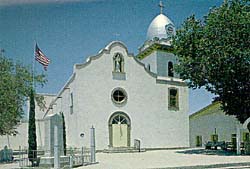
Ysleta is a community in El Paso, Texas, United States. Ysleta was settled between October 9 and October 12, 1680, when Spanish conquistadors, Franciscan clerics and Tigua Indians took refuge along the southern bank of the Rio Grande. These people were fleeing the Pueblo Revolt in New Mexico. Ysleta is the oldest European settlement in the area that is the present-day U.S. state of Texas.

Beginning in the 16th century Spain established missions throughout New Spain in order to facilitate colonization of these lands.
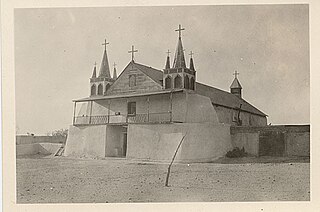
San Agustín de la Isleta Mission, founded in 1613, was a Spanish Mission in what is now Bernalillo County, New Mexico, United States. It was a religious outpost established by Spanish Catholic Franciscans, to spread Christianity among the local Native Americans.
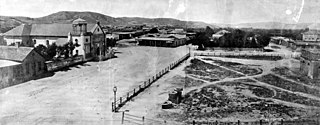
El Pueblo de Nuestra Señora la Reina de los Ángeles, shortened to Pueblo de los Ángeles, was the Spanish civilian pueblo settled in 1781, which became the American metropolis of Los Angeles. The pueblo was built using labor from the adjacent village of Yaanga and was totally dependent on local Indigenous labor for its survival.
Antonio de Otermín was the Spanish Governor of the northern New Spain province of Santa Fe de Nuevo México, today the U.S. states of New Mexico and Arizona, from 1678 to 1682. He was governor at the time of the Pueblo Revolt, during which the religious leader Popé led the Pueblo people in a military ouster of the Spanish colonists. Otermín had to cope with the revolt with help of the settlers and their descendants in New Mexico, fighting against the Pueblo in some military campaigns and establishing a refuge for the surviving settlers and loyal native Pueblo in the vicinity of the modern Ciudad Juárez, current Mexico.
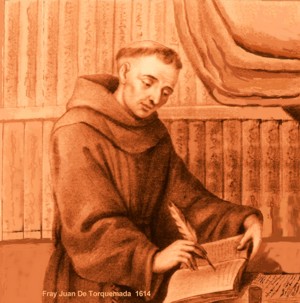
Juan de Torquemada was a Franciscan friar, active as missionary in colonial Mexico and considered the "leading Franciscan chronicler of his generation." Administrator, engineer, architect and ethnographer, he is most famous for his monumental work commonly known as Monarquía indiana, a survey of the history and culture of the indigenous peoples of New Spain together with an account of their conversion to Christianity, first published in Spain in 1615 and republished in 1723. Monarquia Indiana was the "prime text of Mexican history, and was destined to influence all subsequent chronicles until the twentieth century." It was used by later historians, the Franciscan Augustin de Vetancurt and most importantly by 18th-century Jesuit Francisco Javier Clavijero. No English translation of this work has ever been published.

The Spanish missions in Baja California were a large number of religious outposts established by Catholic religious orders, the Jesuits, the Franciscans and the Dominicans, between 1683 and 1834. The missionary goal was to spread the Christian doctrine among the Indigenous peoples living on the Baja California peninsula. The missions gave Spain a valuable toehold in the frontier land, and would also act as a deterrent to prevent pirates from using the peninsula of Las Californias as a jumping off point for contraband trade with mainland New Spain. Missionaries introduced European livestock, fruits, vegetables, and industry into the region. Indigenous peoples were severely impacted by the introduction of European diseases such as smallpox and measles; furthermore, the expulsion of the Jesuits from the Spanish Empire in 1767 ripped the social fabric of the peninsula, although Franciscans were sent to replace them. In 1769, the Franciscans moved to Upper California, leaving Dominicans in charge of Baja California. By 1800 indigenous numbers were a fraction of what they had been before the arrival of the Spanish, yet even today many people living in Baja California are of indigenous heritage.
José Torrubia was born in 1698 in Spain, professed his vows as priest and as a Franciscan in 1714. He was also a naturalist.
Agustín de Vetancurt was a Mexican Catholic historian and scholar of the Nahuatl language. Born in Mexico City, Vetancurt became a Franciscan in Puebla, where he spent 40 years amongst the indigenous. He was official chronicler of the Order, so much of his most important work Teatro Mexicano deals with matters of interest to its members. But it is not only a history of the Franciscans in Mexico, but also a wide-ranging discussion of indigenous history and customs, topics of great interest to Franciscans of the first generation in Mexico. He drew upon the works of fellow Franciscans Gerónimo de Mendieta and Juan de Torquemada. Although he recapitulates some material from his sources, there is considerable material on prehispanic and colonial indigenous not found elsewhere and particularly valuable for the seventeenth century. He was helped in his work by Don Carlos de Siguenza y Gongora, and it is possible that some information on prehispanic indigenous culture came from him. Vetancurt accused his Franciscan predecessor Fray Juan de Torquemada, author of Monarquia Indiana, of plagiarizing the work of Gerónimo de Mendieta.

Felipe de Neve y Padilla was a Spanish soldier who served as the 4th Governor of the Californias, from 1775 to 1782. Neve is one of the founders of Los Angeles and was instrumental in the foundation of San Jose and Santa Barbara.
Mission San Lorenzo was established near El Paso del Norte by Fray Francisco Ayeta. Arriving there on October 9, 1680, Governor Antonio de Otermín established the site as his headquarters after fleeing the Pueblo revolt. Suma Indians then occupied the area, with their numbers falling from 155 in 1750 to 58 in 1760. Eventually incorporated into the town of Ascarate, the area is now part of El Paso, Texas.
Francisco Pareja, OFM was a Franciscan missionary in Spanish Florida, where he was primarily assigned to Mission San Juan del Puerto. The Spaniard became a spokesman for the Franciscan community to the Spanish and colonial governments, was a leader among the missionaries, and served as custodio for the community in Florida. After the Franciscan organization was promoted to a provincia (province), Pareja was elected by his fellow missionaries as provincial in 1616.
Alonso de Benavides was a Portuguese Franciscan missionary active in New Mexico in the early part of the seventeenth century.
Isidro Félix de Espinosa (1679–1755) was a Franciscan missionary from New Spain who participated in several expeditionary missions throughout the province of Tejas. He was the president of the missionaries from the College of Santa Cruz de Querétaro.
Estéban de Perea was a Spanish Franciscan friar who undertook missionary work in New Mexico, a province of New Spain, between 1610 and 1638. At times he was in conflict with the governors of the province. He has been called the "Father of the New Mexican Church".
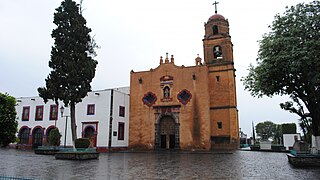
Santa María Tepepan is one of the 14 recognized original pueblos that form the México City´s borough of Xochimilco. It sits on the lower edges of the mountain chain that limits Mexico City to the south. Although it is in Mexico City's territory, it conserves a lot of rural characteristics, like winding cobblestone streets, and economic activities, equestrianism being one of the most important ones until recently.
Juan Agustín Morfi was a Franciscan friar, born in Asturias, Spain, in 1735, who died in Mexico, New Spain, in 1783. He is considered the most important chronicler and historian of the New Philippines; Mariano Errasti ranks Morfi among the most prodigious figures in five centuries of Franciscan work in America.








